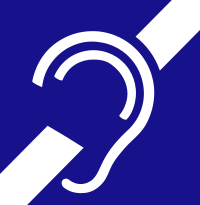
Photo from wikipedia
OBJECTIVE Newborns from Neonatal intensive care units (NICU) are at high-risk for sensorineural hearing loss (SNHL) a follow-up is needed for early diagnosis and intervention. Our objective here was to… Click to show full abstract
OBJECTIVE Newborns from Neonatal intensive care units (NICU) are at high-risk for sensorineural hearing loss (SNHL) a follow-up is needed for early diagnosis and intervention. Our objective here was to describe the features and changes of SNHL at different periods during a follow-up of almost 20 years. METHODS Risk factors for SNHL during development were analyzed. The audiological examination included: Brainstem auditory evoked potentials (BAEP), and Transient evoked otoacoustic emissions (TEOAE). At birth; tonal audiometry (between 125 and 8000 Hz), and tympanometry were performed at 5, 10, 15, and 20 years of age. RESULTS Sixty-five percent of cases presented bilateral absence of BAEP. At 5 years of age, the most frequent SNHL level was severe (42.5%), followed by moderate (22.5%), and profound level (20%), in all cases, the SNHL was symmetrical with a predominance of lesion for the high frequencies. Exchange transfusion was associated with a higher degree of SNHL (OR = 6.00, CI = 1.11-32.28, p < 0.02). In 55%, SNHL remained stable, but in 40% of the cases it was progressive. At the end of the study six cases with moderate loss progressed to the severe level and seven cases with severe level progressed to profound. CONCLUSIONS Forty percent of infants with SNHL discharged from NICU may present a progression in the hearing loss. Exchange transfusion was associated with a higher degree of SNHL. NICU graduates with SNHL merit a long-term audiological follow-up throughout their lifespan.
Journal Title: International journal of pediatric otorhinolaryngology
Year Published: 2017
Link to full text (if available)
Share on Social Media: Sign Up to like & get
recommendations!